Relationship between Ultraviolet-B Radiation and Broadband Solar Radiation under All Sky Conditions in Kuwait Hot Climate
Abstract
1. Introduction
2. Methodology
3. Statistical Methods
4. Experimental Setup
4.1. UVB Radiation Measurements
4.2. Global Radiation Measurements
5. Error Analysis
6. Results and Discussions
6.1. Hourly Analysis
6.2. Daily Analysis
6.3. Monthly Analysis
7. Conclusions
- Hourly curves show a sinusoidal behavior for both G and UVB radiation, with minimum values in January and December.
- The higher changes in G and UVB radiation in spring and summer seasons are related to frequent dust storms as well as dust/sandstorms in Kuwait at these times of the year.
- Maximum hourly G and UVB radiation takes place in summer months at midday (12 h).
- There is a good agreement between hourly G and hourly UVB radiation as R2 values for all years are greater than 0.91. In addition, RMSE and MBE values are very small and smaller than the measurement errors.
- The measured versus predicted hourly curves of UVB for all years reveal the strong correlation between both factors. The slope of the line for these curves is very close to unity for all years, and most of the data are situated close to the best-fit line, showing good consistency between measured and predicted UVB.
- The attenuation in maximum G is about 5.5% during the whole period of measurements, while it is about 35% for UVB, which is much higher.
- The hourly percentage ratio (UVB/G) decreases with hourly G as a result of cloudy sky variations.
- High absorption by water vapor attenuates G radiation more efficiently than UVB, while the attenuation by aerosols and ozone is greater for UVB than G radiation.
- The (UVB/G) ratio tends to decrease with KT, indicating that a higher ratio of (UVB/G) can be obtained for cloudier conditions.
- KT is directly proportional to KTUVB with a third-order polynomial giving an acceptable formula, i.e., determination coefficient = 0.859.
- Measurements for the four central hours of each day are utilized to avoid the dependency of clearness indices on solar zenith angle. Relying on these four hours only, the determination coefficient of the linear correlation between the two indices is greatly enhanced from 0.859 to 0.933.
- The graphs of daily G and UVB radiation for all years show the same behavior. In addition, these graphs indicate a sinusoidal behavior.
- G and UVB values are very well correlated on a daily basis, as demonstrated by the statistical analysis parameters for each year. The coefficient of determination is significantly improved, and it is very close to unity for all years.
- The values of RMSE and MBE obtained from daily analysis are greatly enhanced compared to the values obtained for hourly analysis as the values of RMSE and MBE are almost zero.
- G and UVB have similar monthly behavior for all years. Minimum values of G and UVB occur in the cold months, i.e., November to January.
- The minimum G radiation obtained is 9.51 MJ/m2 in January 2019 and the minimum UVB radiation attained is 0.00089 MJ/m2 in November 2017.
- The maximum G and UVB radiation obtained are 27.94 MJ/m2 and 0.0044 MJ/m2, respectively, both of which occur in June 2015.
- There is an excellent linear fit between the monthly G and UVB radiation as R2 is almost equal to unity. In addition, the values of RMSE and MBE are greatly decreased compared to the values obtained for hourly analysis.
- The present results indicate that the derived daily and monthly empirical formulas can be utilized, with a very high accuracy, to predict both daily and monthly UVB values from G values for locations with no UVB sensors.
Author Contributions
Funding
Institutional Review Board Statement
Informed Consent Statement
Data Availability Statement
Acknowledgments
Conflicts of Interest
References
- Xia, X.; Li, Z.; Wang, P.; Cribb, M.; Chen, H.; Zhao, Y. Analysis of relationships between ultraviolet radiation (295–385 nm) and aerosols as well as shortwave radiation in North China Plain. Ann. Geophys. 2008, 26, 2043–2052. [Google Scholar] [CrossRef][Green Version]
- Ogunjobi, K.O.; Kim, Y. Ultraviolet (0.28–0.4 lm) and broadband solar hourly radiation at Kwangju, South Korea: Analysis of their correlation with aerosol optical depth and clearness index. Atmos. Res. 2004, 71, 193–214. [Google Scholar] [CrossRef]
- Kripke, M. Effect on human health. In UVB Monitoring Workshop: A Review of the Science and Status of Measuring and Monitoring Programs; AFEAS, Science and Policy Associates, Inc.: Washington, DC, USA, 1992. [Google Scholar]
- Webb, A.R. Techniques for measuring solar ultraviolet radiation. In Advances in Bioclimatology: Human Bioclimatology; Auliciems, A., Ed.; Springer-Verlag: Berlin/Heidelberg, Germany, 1998. [Google Scholar]
- Juzeniene, A.; Brekke, P.; Dahlback, A.; Andersson-Engels, S.; Reichrath, J.; Moan, K.; Holick, M.; Grant, W.; Moan, J. Solar radiation and human health. Rep. Prog. Phys. 2011, 74, 66701–66757. [Google Scholar] [CrossRef]
- Koronakis, P.S.; Sfantos, G.K.; Paliatsos, A.G.; Kaldellis, J.K.; Garofalakis, J.E.; Koronakis, I.P. Interrelations of UV-global/global/diffuse solar irradiance components and UV-global attenuation on air pollution episode days in Athens, Greece. Atmos. Environ. 2002, 36, 3173–3181. [Google Scholar] [CrossRef]
- Canada, J.; Pedros, G.; Bosca, J.V. Relationships between UV (0.295–0.385 lm) and broadband solar radiation hourly values in Valencia and Co’rdoba, Spain. Energy 2003, 28, 199–217. [Google Scholar] [CrossRef]
- Palancar, G.G.; Toselli, M.B. Effects of meteorology on the annual and interannual cycle of the UV-B and total radiation in Co´rdoba City, Argentina. Atmos. Environ. 2004, 38, 1073–1082. [Google Scholar] [CrossRef]
- Koepke, P.; De Backer, H.; Bais, A.; Curylo, A.; Eerme, K.; Feister, U.; Johnsen, B.; Junk, J.; Kazantzidis, A.; Krzyscin, J.; et al. Modelling solar UV radiation in the past: Comparison of algorithms and input data. Proc. SPIE Int. Soc. Opt. Eng. 2006, 6362, 636215.1–636215.11. [Google Scholar]
- Murillo, W.; Canãda, J.; Pedrόs, G. 2003. Correlation between global ultraviolet (290–385 nm) and global irradiation in Valencia and Co´rdoba, Spain, Renew. Energy 2003, 28, 409–418. [Google Scholar]
- Robaa, S.M. A study of ultraviolet solar radiation at the Cairo urban area, Egypt. Sol. Energy 2004, 77, 251–259. [Google Scholar] [CrossRef]
- Foyo-Moreno, I.; Alados, I.; Alados-Arboledas, L. Adaptation of an empirical model for erythemal ultraviolet irradiance. Ann. Geophys. 2007, 25, 1499–1508. [Google Scholar] [CrossRef]
- El Shazly, S.M.; Kassem, K.O.; Hassan, A.; El-Nobi, E.F. An Empirical Model to Estimate UV index in Some Upper Egypt Regions. Resour. Environ. 2012, 2, 216–227. [Google Scholar] [CrossRef]
- Serrano, M.A.; Bosca, J.V. Selection of cloudless sky conditions by applying solar global ultraviolet irradiance measurements. Atmos. Res. 2013, 132–133, 291–298. [Google Scholar] [CrossRef]
- Gandía, S.; Utrillas, M.P.; Gómez-Amo, J.L.; Esteve, A.R.; Estellés, V.; Pedrós, R.; Núñez, J.A.; Martínez Lozano, J.A. Relationship between UVB and broadband solar radiation in Spain: UVB and broadband solar radiation in Spain. Int. J. Climatol. 2015, 35, 1761–1771. [Google Scholar] [CrossRef]
- Adam, M.E.-N. 2015. Determination of daily total ultraviolet-B in a subtropical region (Upper Egypt): An empirical approach. Atmos. Res. 2015, 153, 1–9. [Google Scholar] [CrossRef]
- Gurrea, G.; Solar Radiation Group of the Universitat Politècnica de València; Blanca-Giménez, V.; Pérez, V.; Serrano, M.-A.; Moreno, J.-C. Statistical Study and Prediction of Variability of Erythemal Ultraviolet Irradiance Solar Values in Valencia, Spain. Asia-Pac. J. Atmospheric Sci. 2018, 54, 599–610. [Google Scholar] [CrossRef]
- Elani, U.A. Distribution of ultraviolet solar Radiation at Riyadh region, Saudi Arabia. Environ. Monit. Assess. 2007, 124, 235–241. [Google Scholar] [CrossRef]
- Kudish, A.I.; Evseev, E.G. UVB irradiance and atmospheric optical depth at the Dead Sea basin, Israel: Measurements and modeling. Renew. Energy 2012, 48, 344–349. [Google Scholar] [CrossRef]
- Villán, D.M.; Castrillo, A.M.; Santos, J.B. Empirical models of UV total radiation and cloud effect study. Int. J. Climatol. 2010, 30, 1407–1415. [Google Scholar]
- Kudish, A.I.; Lyubansky, V.; Evseev, E.G.; Ianetz, A. Inter-comparison of the solar UVB, UVA and global radiation clearness and UV indices for Beer Sheva and Neve Zohar (Dead Sea), Israel. Energy 2005, 30, 1623–1641. [Google Scholar] [CrossRef]
- Leal, S.S.; Tíba, C.; Piacentini, R. 2011. Daily UV radiation modeling with the usage of statistical correlations and artificial neural networks. Renew. Energy 2011, 36, 3337–3344. [Google Scholar] [CrossRef]
- Ghoneim, A.A.; Kadad, I.M.; Altouq, M.S. Statistical analysis of solar UVB and global radiation in Kuwait. Energy 2013, 60, 23–34. [Google Scholar] [CrossRef]
- Basset, A.H.; Korany, H.M. Global and UVB radiation over Egypt. Atmosfera 2007, 20, 341–358. [Google Scholar]
- Feister, U.; Grasnick, K.H. Solar UV radiation measurements at Potsdam (52 2200N, 13 5000E). Sol. Energy 1992, 49, 541–548. [Google Scholar] [CrossRef]
- Cui, X.; Gu, S.; Zhao, X.; Wu, J.; Kato, T.; Tang, Y. Diurnal and seasonal variations of UV radiation on the northern edge of the Qinghai-Tibetan Plateau. Agric. For. Meteorol. 2008, 148, 144–151. [Google Scholar] [CrossRef]
- Adam, M.E.; Kassem, K.O.; Ahmed, E.A. Statistical relationship between UVB (280–320 nm) and broad band solar radiation (295–2800 nm) at a subtropical location (Qena, Egypt). Atmos. Ocean. Sci. Lett. 2013, 6, 173–178. [Google Scholar] [CrossRef]
- Jacovides, C.; Assimakopoulos, V.; Tymvios, F.; Theophilou, K.; Asimakopoulos, D. Solar global UV (280–380nm) radiation and its relationship with solar global radiation measured on the island of Cyprus. Energy 2006, 31, 2728–2738. [Google Scholar] [CrossRef]
- Trabea, A.A.; Salem, A.I. Empirical relationship for ultraviolet solar radiation over Egypt. Egypt J. Sol. Energy 2001, 24, 123–132. [Google Scholar]
- Martinez-Lozano, J.A.; Tena, F.; Utrillas, M.P. Ratio of UV to global broad band irradiation in Valencia, Spain. Int. J. Climatol. 1999, 19, 903–911. [Google Scholar] [CrossRef]
- Lee, H.; Kim, W.; Lee, Y.G.; Koo, J.-H.; Jung, Y.; Park, S.S.; Cho, H.-K.; Kim, J. Broadband dependence of atmospheric transmissions in the UV and total solar radiation. Tellus B Chem. Phys. Meteorol. 2019, 71, 1503513. [Google Scholar] [CrossRef]
- Lee, H.; Kim, W.; Lee, Y.G.; Kim, J.; Cho, H.K. Atmospheric transmission of ultraviolet and total solar radiation by clouds, aerosols, and ozone in Seoul, Korea: A comparison of semi-empirical model predictions with observations. Asia Pac. J. Atmos. Sci. 2019, 55, 165–175. [Google Scholar] [CrossRef]
- Lee, S.; Hong, J.; Cho, Y.; Choi, M.; Kim, J.; Park, S.S.; Ahn, J.-Y.; Kim, S.-K.; Moon, K.-J.; Eck, T.F. Characteristics of Classified Aerosol Types in South Korea during the MAPS-Seoul Campaign. Aerosol. Air Qual. Res. 2018, 18, 2195–2206. [Google Scholar] [CrossRef]
- Kim, J.; Lee, Y.G.; Koo, J.-H.; Lee, H. Relative Contributions of Clouds and Aerosols to Surface Erythemal UV and Global Horizontal Irradiance in Korea. Energies 2020, 13, 1504. [Google Scholar] [CrossRef]
- Libra, M.; Beránek, V.; Sedláček, J.; Poulek, V.; Tyukhov, I. Roof photovoltaic power plant operation during the solar eclipse. Sol. Energy 2016, 140, 109–112. [Google Scholar] [CrossRef]
- Samy, A.; Khalil, S.A.; Rahoma, U.A.; Hassan, A.H.; Greeb, R.M. Assessment of UVB solar radiation in four different selected climate locations in Saudi Arabia. NRIAG J. Astron. Geophys. 2021, 10, 125–137. [Google Scholar]
- Duffie, J.A.; Beckman, W.A. Solar Engineering of Thermal Processes, 4th ed.; John Wiley & Sons Inc.: New York, NY, USA, 2013. [Google Scholar]
- Foyo-Moreno, I.; Vida, J.; Alados-Arboledas, L. A simple all weather model to estimate ultraviolet solar radiation (290–385 nm). J. Appl. Meteorol. 1999, 38, 1020–1026. [Google Scholar] [CrossRef]
- Antón, M.; Serrano, A.; Cancillo, M.L.; Garcia, J.A. An empirical model to estimate ultraviolet erythemal transmissivity. Ann. Geophys. 2009, 27, 1387–1398. [Google Scholar] [CrossRef]
- Serrano, A.; Anton, M.; Cancillo, M.L.; Garcia, J.A. Proposal of a new erythemal UV radiation amplification factor. Atmos. Chem. Phys. Discuss. 2008, 8, 1089–1111. [Google Scholar]
- Adam, M.E. Effect of stratospheric ozone in UVB solar radiation reaching the earth’s surface at Qena, Egypt. Atmos. Pollut. Res. 2010, 1, 155–160. [Google Scholar]
- Anton, M.; Serrano, A.; Cancillo, M.L.; García, J.A. Relationship between erythemal irradiance and total solar irradiance in southwestern Spain. J. Geophys. Res. 2008, 113, D14. [Google Scholar]
- Frederick, J.E.; Erlick, C. The attenuation of sunlight by high-latitude clouds: Spectral dependence and its physical mechanisms. J. Atmos. Sci. 1997, 54, 2813–2819. [Google Scholar] [CrossRef]
- Wang, L.; Gong, W.; Li, J.; Ma, Y.; Hu, B. Empirical studies of cloud effects on ultraviolet radiation in Central China: UV radiation in central China. Int. J. Climatol. 2014, 34, 2218–2228. [Google Scholar] [CrossRef]
- Tena, F.; Martínez-Lozano, J.A.; Utrillas, M.P.; Marín, M.J.; Esteve, A.R.; Cañada, J. The erythemal clearness index for Valencia, Spain. Int. J. Clim. 2008, 29, 147–155. [Google Scholar] [CrossRef]
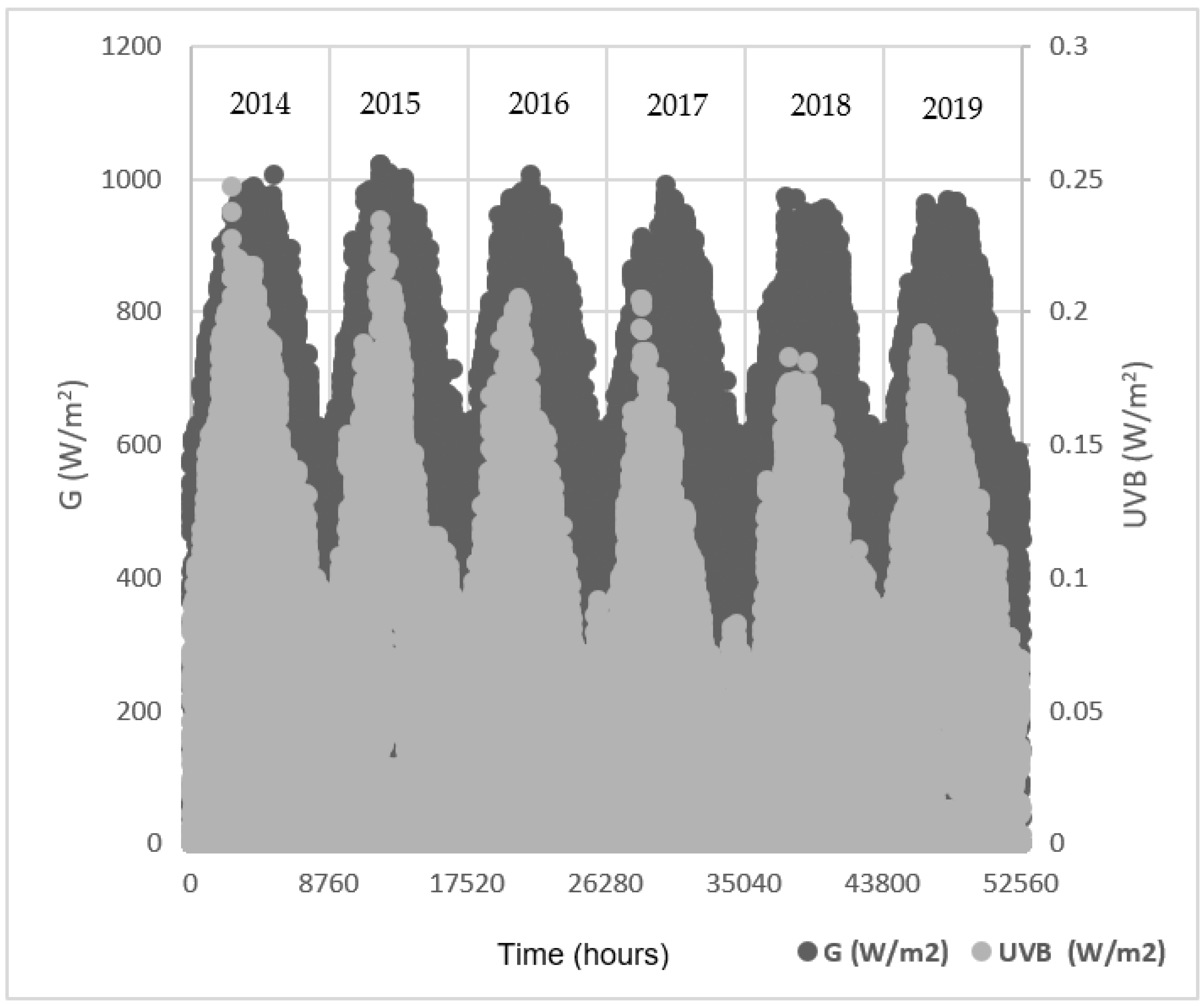
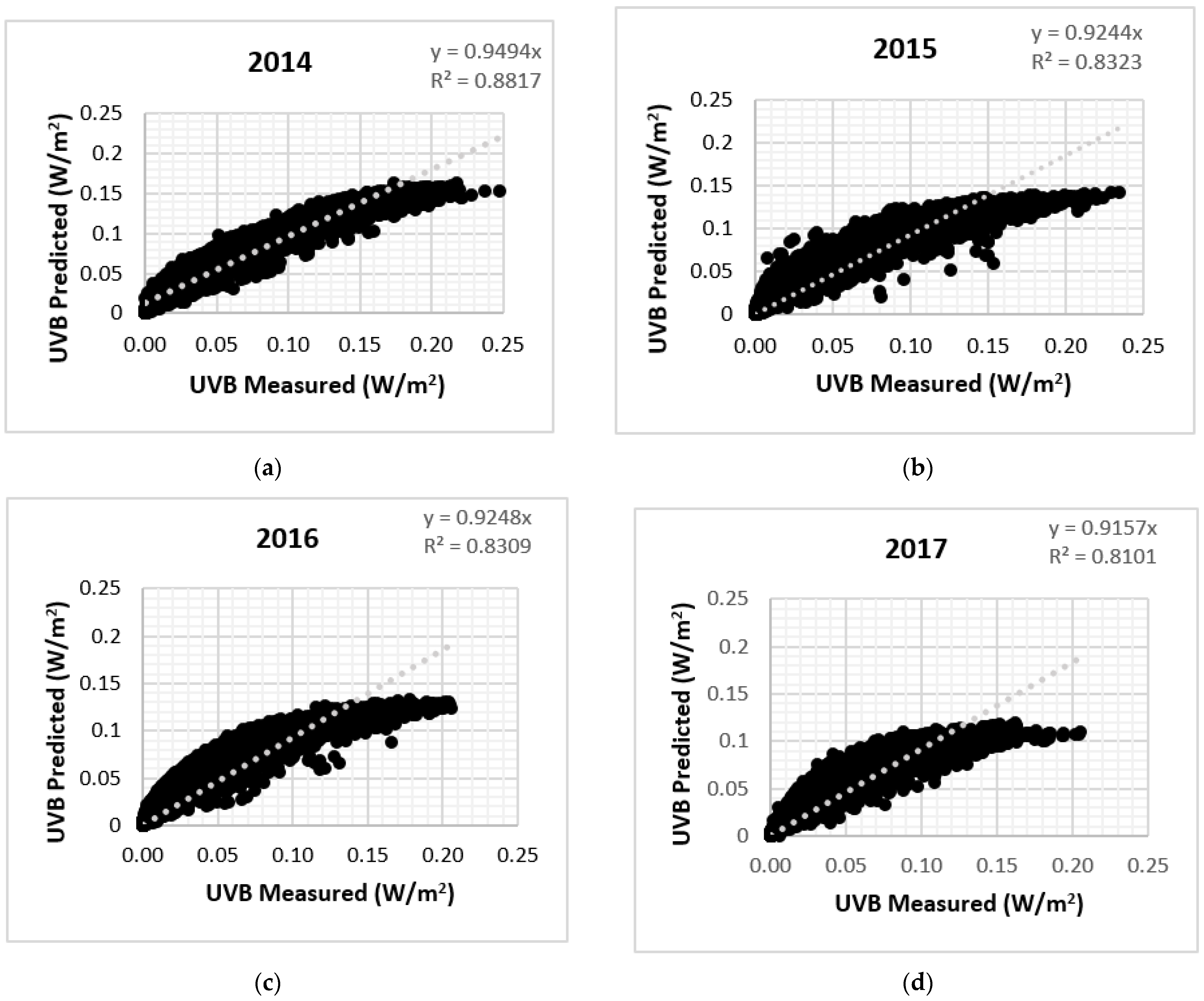



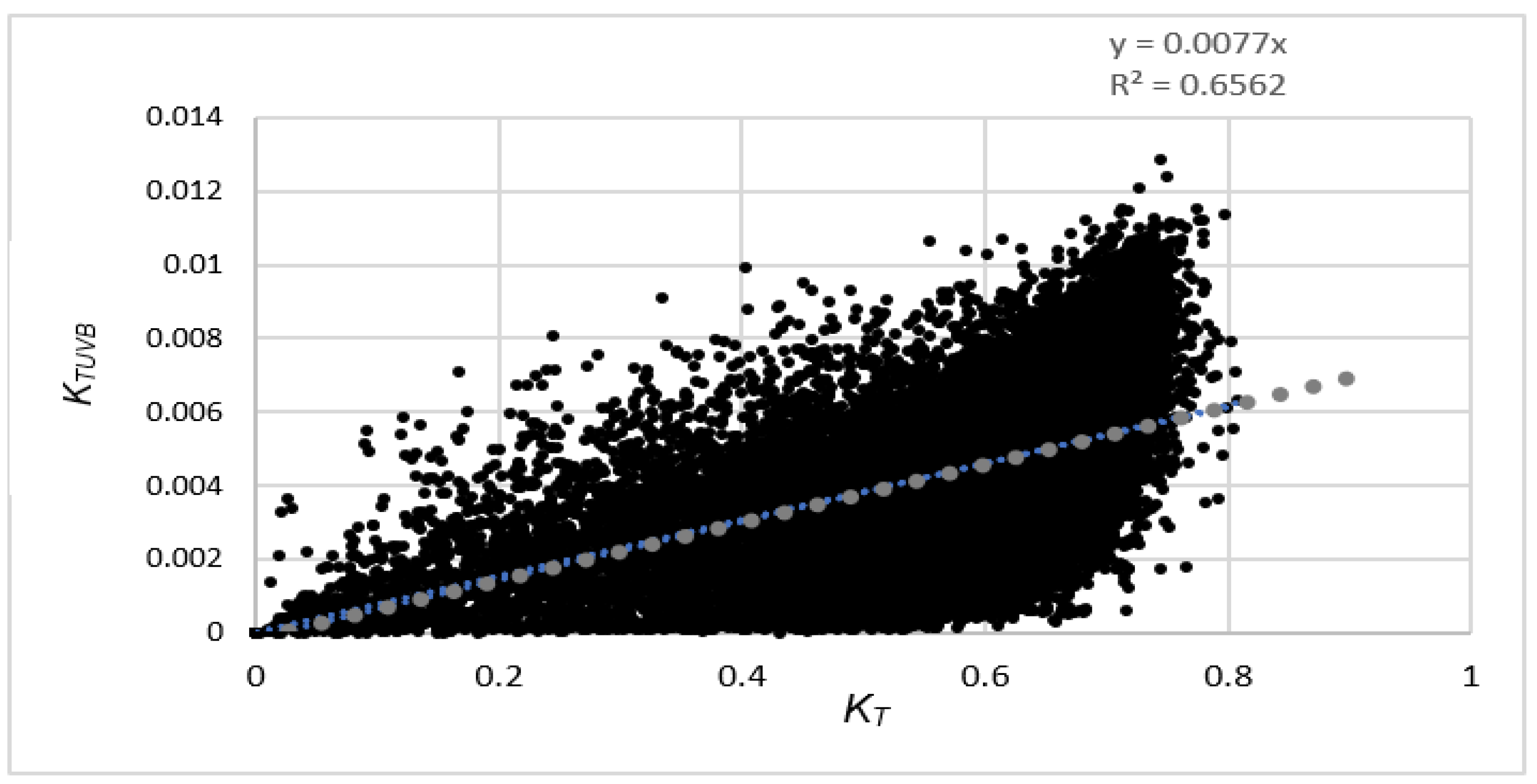

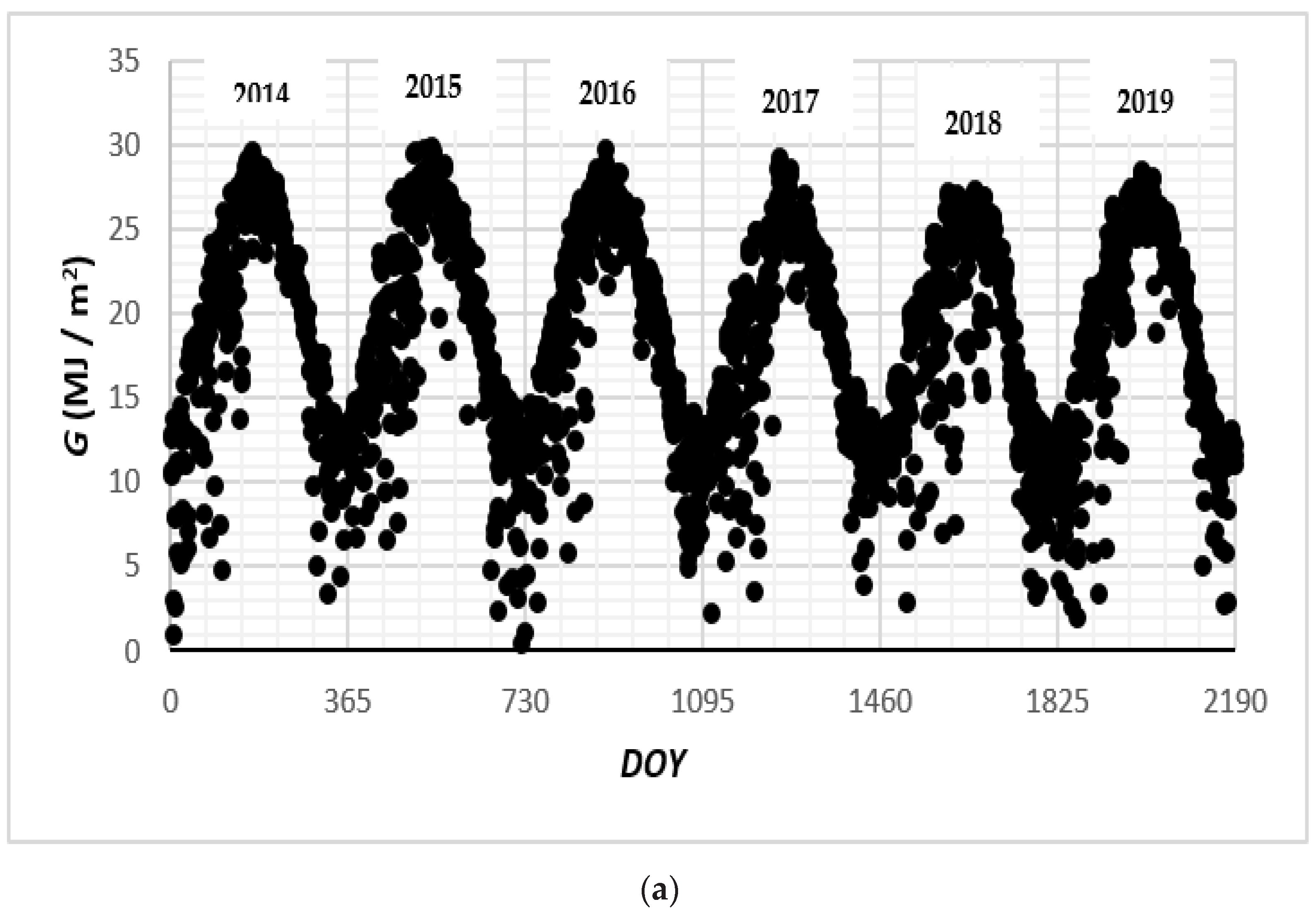
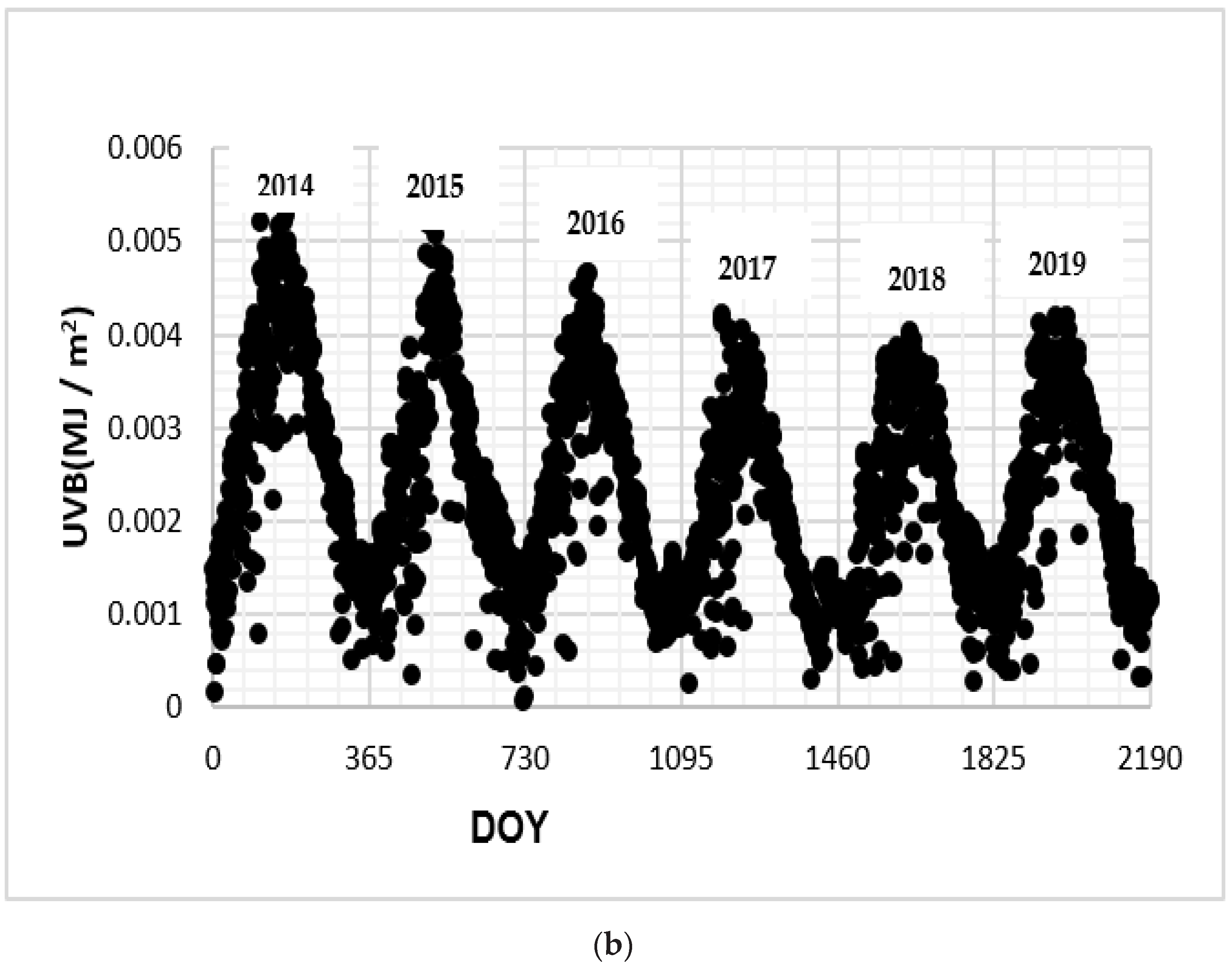


| Parameter | Value |
|---|---|
| Radiation detection range | 400–1100 nm |
| Incident angle correction | Cosine corrected up to 82° |
| Calibration frequency | Two years |
| Calibration uncertainty | ±3% typical, within ±60° angle of incidence |
| Typical sensitivity | 75 μA per 1000 W/m2 |
| Maximum deviation | 1% at 3000 W/m2 |
| Stability | <±2% change per annum |
| Response | <1 µs |
| Year | Relationship between G and UVB | RMSE | MBE | R2 |
|---|---|---|---|---|
| 2014 | UVB = G × 0.000162 | 0.0178 | 0.0046 | 0.949 |
| 2015 | UVB = G × 0.000139 | 0.0183 | 0.0037 | 0.927 |
| 2016 | UVB = G × 0.000133 | 0.0176 | 0.0035 | 0.927 |
| 2017 | UVB = G × 0.000120 | 0.0162 | 0.0028 | 0.917 |
| 2018 | UVB = G × 0.000120 | 0.0186 | −0.0011 | 0.917 |
| 2019 | UVB = G × 0.000133 | 0.0200 | 0.0026 | 0.912 |
| Year | G (W/m2) | UVB (W/m2) | ||
|---|---|---|---|---|
| Max | Date | Max | Date | |
| 2014 | 1006.4 | 18 June | 0.247 | 20 April |
| 2015 | 1022 | 17 May | 0.235 | 17 May |
| 2016 | 1007 | 14 June | 0.205 | 16 May |
| 2017 | 991.3 | 5 June | 0.205 | 5 April |
| 2018 | 974.5 | 18 April | 0.183 | 26 April |
| 2019 | 968.9 | 21 June | 0.192 | 14 April |
| Year | G (MJ/m2) | UVB (MJ/m2) | ||
|---|---|---|---|---|
| Max | Date | Max | Date | |
| 2014 | 29.63 | 18 June | 0.0053 | 18 June |
| 2015 | 29.83 | 21 June | 0.0052 | 17 May |
| 2016 | 29.69 | 14 June | 0.0047 | 22 May |
| 2017 | 29.23 | 5 June | 0.0042 | 5 April |
| 2018 | 27.37 | 14 July | 0.0041 | 18 June |
| 2019 | 28.41 | 22 June | 0.0040 | 23 May |
| Year | Relationship between G and UVB | RMSE | MBE | R2 |
|---|---|---|---|---|
| 2014 | UVB = G × 0.000152 | 0.00067 | 0.985 | |
| 2015 | UVB = G × 0.000131 | 0.00072 | 0.966 | |
| 2016 | UVB = G × 0.000126 | 0.00063 | 0.966 | |
| 2017 | UVB = G × 0.000114 | 0.00067 | 0.951 | |
| 2018 | UVB = G × 0.000125 | 0.00062 | 0.966 | |
| 2019 | UVB = G × 0.000127 | 0.00061 | 0.975 |
| Month | Relationship between G and UVB | RMSE | MBE | R2 |
|---|---|---|---|---|
| January | UVB = G × 0.000111 | 0.999 | ||
| February | UVB = G × 0.000123 | 0.992 | ||
| March | UVB = G × 0.000135 | 0.998 | ||
| April | UVB = G × 0.000149 | 0.998 | ||
| May | UVB = G × 0.000151 | 0.999 | ||
| June | UVB = G × 0.000143 | 0.00087 | 0.998 | |
| July | UVB = G × 0.000132 | 0.00055 | 0.999 | |
| August | UVB = G × 0.000120 | 0.00026 | 0.998 | |
| September | UVB = G × 0.000105 | 0.00014 | 0.999 | |
| October | UVB = G × 0.000101 | 0.00019 | 0.996 | |
| November | UVB = G × 0.000108 | 0.00010 | 0.995 | |
| December | UVB = G × 0.000112 | 0.00004 | 0.999 |
Publisher’s Note: MDPI stays neutral with regard to jurisdictional claims in published maps and institutional affiliations. |
© 2022 by the authors. Licensee MDPI, Basel, Switzerland. This article is an open access article distributed under the terms and conditions of the Creative Commons Attribution (CC BY) license (https://creativecommons.org/licenses/by/4.0/).
Share and Cite
Kadad, I.M.; Ramadan, A.A.; Kandil, K.M.; Ghoneim, A.A. Relationship between Ultraviolet-B Radiation and Broadband Solar Radiation under All Sky Conditions in Kuwait Hot Climate. Energies 2022, 15, 3130. https://doi.org/10.3390/en15093130
Kadad IM, Ramadan AA, Kandil KM, Ghoneim AA. Relationship between Ultraviolet-B Radiation and Broadband Solar Radiation under All Sky Conditions in Kuwait Hot Climate. Energies. 2022; 15(9):3130. https://doi.org/10.3390/en15093130
Chicago/Turabian StyleKadad, Ibrahim M., Ashraf A. Ramadan, Kandil M. Kandil, and Adel A. Ghoneim. 2022. "Relationship between Ultraviolet-B Radiation and Broadband Solar Radiation under All Sky Conditions in Kuwait Hot Climate" Energies 15, no. 9: 3130. https://doi.org/10.3390/en15093130
APA StyleKadad, I. M., Ramadan, A. A., Kandil, K. M., & Ghoneim, A. A. (2022). Relationship between Ultraviolet-B Radiation and Broadband Solar Radiation under All Sky Conditions in Kuwait Hot Climate. Energies, 15(9), 3130. https://doi.org/10.3390/en15093130






